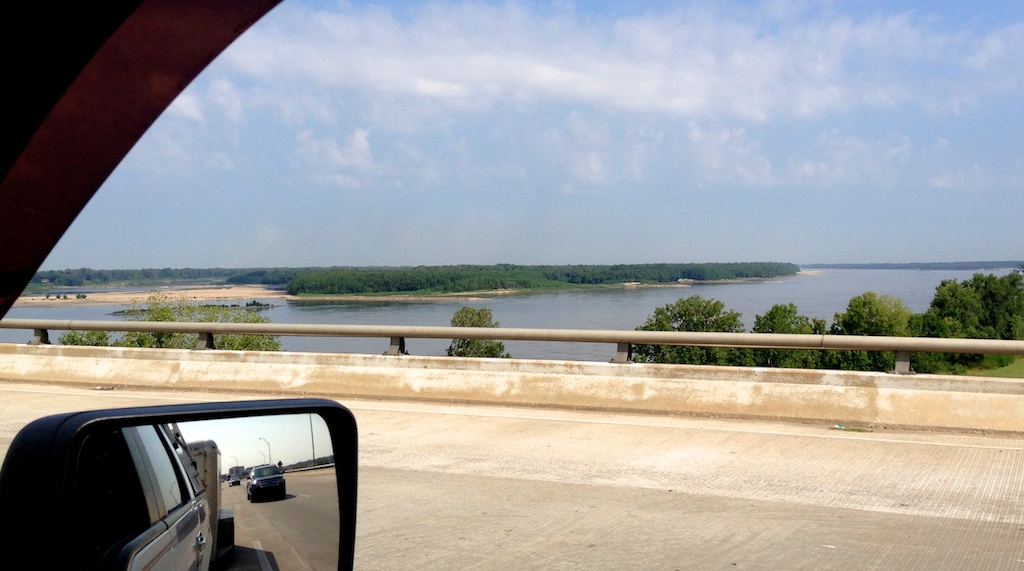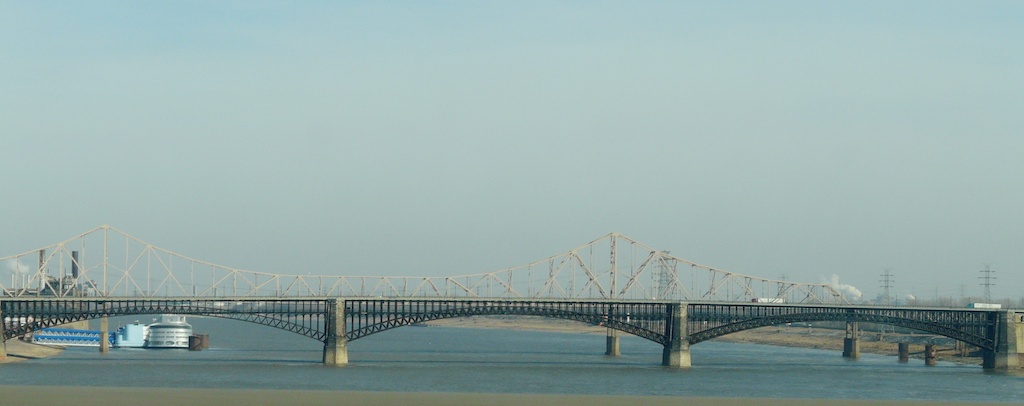 I stopped in western Tennessee last night, and shortly after starting up again this morning I encountered the second major geological obstacle on my trip from Virginia to California: the Mississippi River.Fortunately for me, since I'm traveling in 2014, the river did not actually present much of an obstacle. The Hernando de Soto Bridge carries Interstate 40 over the river between Tennessee and Arkansas, so I barely had to slow down:
I stopped in western Tennessee last night, and shortly after starting up again this morning I encountered the second major geological obstacle on my trip from Virginia to California: the Mississippi River.Fortunately for me, since I'm traveling in 2014, the river did not actually present much of an obstacle. The Hernando de Soto Bridge carries Interstate 40 over the river between Tennessee and Arkansas, so I barely had to slow down: Things were not always so easy. Major rivers have traditionally formed major barriers to human dispersal, influencing the direction and rate of the spread of civilizations. The first bridge over the Mississippi was only completed in 1856, between Iowa and Illinois; prior to that time the only way to move goods across the river was by ferry. The oldest surviving bridge over the Mississippi is the Eads Bridge in St. Louis, which was completed in 1874 (seen here with a newer bridge in the background):
Things were not always so easy. Major rivers have traditionally formed major barriers to human dispersal, influencing the direction and rate of the spread of civilizations. The first bridge over the Mississippi was only completed in 1856, between Iowa and Illinois; prior to that time the only way to move goods across the river was by ferry. The oldest surviving bridge over the Mississippi is the Eads Bridge in St. Louis, which was completed in 1874 (seen here with a newer bridge in the background): The Eads Bridge proved to be a technical challenge, in part because of its length of almost 2 km and the novel (for the time) construction methods. Perhaps more significant was the thickness of the unconsolidated sediments at the bottom of the river. The support piers went some 30 m below the bottom of the river before hitting solid rock. Fifteen workers died from decompression sickness during construction of the bridge, working in pressurized caissons below the bottom of the river when the dangers of not properly decompressing were not understood.It's ironic that in the past rivers were such an impediment to movement, because until the invention of the railroad rivers were the only significant means of transporting large amounts of goods inland, and as a result they tend to have lots of people living nearby. Of the 20 most populous metropolitan areas in the United States, 15 are located either on the coast or on navigable rivers, and in many cases both (the exceptions are Dallas, Atlanta, Phoenix, Denver, and Orlando).In the same way that rivers have historically been an impediment to human travel, the dispersal of other organisms can be significantly affected by the presence of a large river. Consider this map of the distribution of the beech tree, Fagus grandifolia, from the USGS:
The Eads Bridge proved to be a technical challenge, in part because of its length of almost 2 km and the novel (for the time) construction methods. Perhaps more significant was the thickness of the unconsolidated sediments at the bottom of the river. The support piers went some 30 m below the bottom of the river before hitting solid rock. Fifteen workers died from decompression sickness during construction of the bridge, working in pressurized caissons below the bottom of the river when the dangers of not properly decompressing were not understood.It's ironic that in the past rivers were such an impediment to movement, because until the invention of the railroad rivers were the only significant means of transporting large amounts of goods inland, and as a result they tend to have lots of people living nearby. Of the 20 most populous metropolitan areas in the United States, 15 are located either on the coast or on navigable rivers, and in many cases both (the exceptions are Dallas, Atlanta, Phoenix, Denver, and Orlando).In the same way that rivers have historically been an impediment to human travel, the dispersal of other organisms can be significantly affected by the presence of a large river. Consider this map of the distribution of the beech tree, Fagus grandifolia, from the USGS: So, while rivers may no longer be a significant obstacle to my road trip, they are still a major factor when considering geologic, biologic, and cultural history.
So, while rivers may no longer be a significant obstacle to my road trip, they are still a major factor when considering geologic, biologic, and cultural history.
